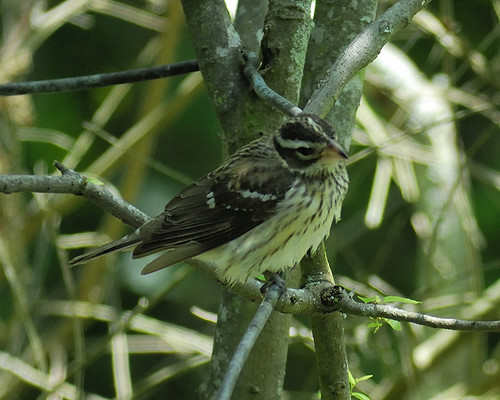tags: Rose-breasted Grosbeak, Pheucticus ludovicianus, birds, mystery bird, bird ID quiz
[Mystery bird] Rose-breasted Grosbeak, Pheucticus ludovicianus, photographed at Sabine Woods and Sabine Pass area, Texas. [I will identify this bird for you tomorrow]
Image: Joseph Kennedy, 28 April 2008 [larger view].
Nikon D200, Kowa 883 telescope TSN-PZ camera eyepiece 1/125s f/8.0 at 1000.0mm iso400.
Please name at least one field mark that supports your identification.
Rick Wright, Managing Director of WINGS Birding Tours Worldwide, writes:
This bird is closely related to the cardinals, as a look at its huge bill reveals. In fact, that bill rules out almost all of the other streaked "finch-like" birds in North America; and in combination with the heavily marked plumage and short tail, puts us in the genus Pheucticus, the non-cardinal cardinal grosbeaks. Black-headed and Rose-breasted Grosbeaks are not just similar but very closely related, and the frequency of hybrids and introgressants between the two has led to their being considered conspecific by various authorities. Female-plumaged birds like this one can be quite challenging to identify, but there are a few good marks shown by this individual that make me confident of its identity as a Rose-breasted Grosbeak.
The regularity and density of streaking beneath is too great for Black-headed Grosbeak, which typically shows sparse, fine streaks against a buffy ground, unlike the clear off-white of this bird's underparts. Bill color is a very useful character, too; Black-headed Grosbeaks show a bicolored bill, dark above and pale below, while Rose-breasted Grosbeaks like this one show pinkish-horn upper and lower mandibles with a variable dark tip. ("Pinkish-horn," by the way, is one of those birderly colors that make no sense whatsoever to the uninitiated!)
There's no way to be certain, of course, that this bird is "pure," but if I saw it in the field, I'd have no compunctions in calling it a Rose-breasted. Just to be sure, though, I'd want to hear it chip: the two Pheucticus breeding in the US and Canada are very similar in their songs, but the contact notes are distinctive and worth learning.
- Log in to post comments


Rose-breasted Grosbeak
I'm not sure what's going on with that dark tip on the beak, and I've been getting everything wrong lately, but I'm going to say that's an adult female Rose-breasted Grosbeak. I'm excluding the Black-headed Grosbeak based on the coarseness of the striping below, and the low amount of the buffy wash on the breast and sides.
Why do you say it's an adult? I thought that I saw two generations of greater coverts when I looked at the photo, making it an SY. Or are my eyes and my monitor creating differences that aren't really there?